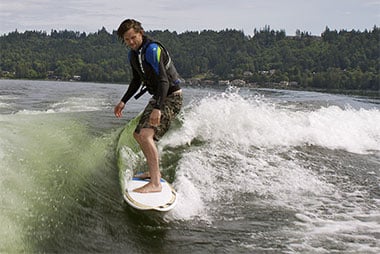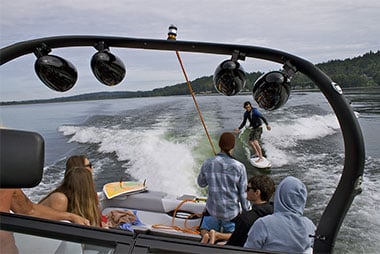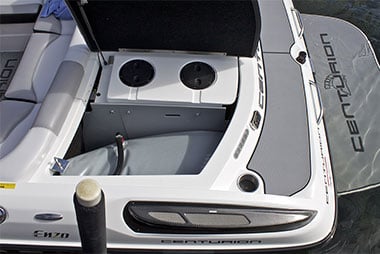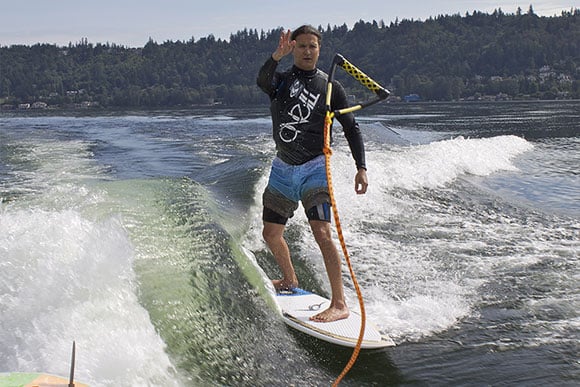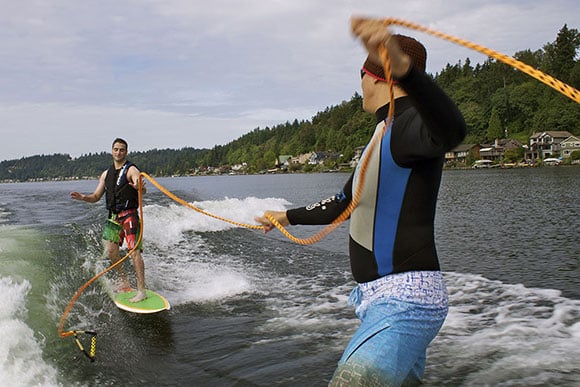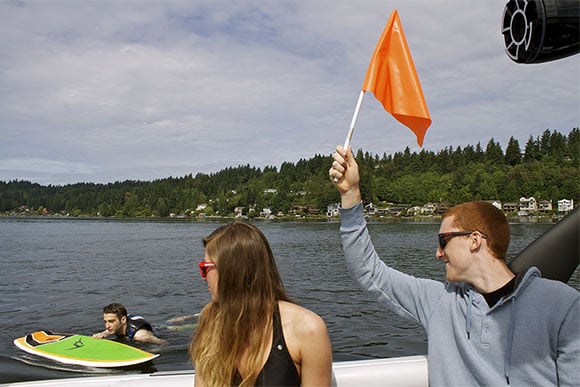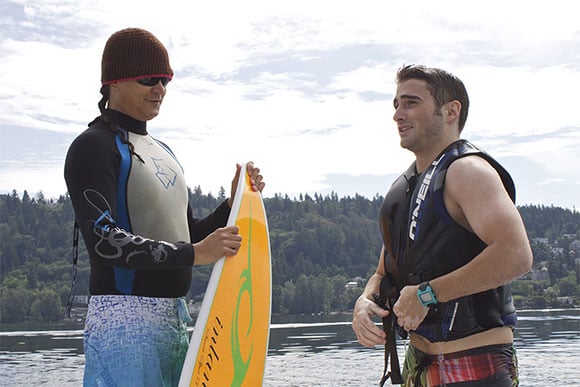How to Setup & Weight Your Boat for Wakesurfing
Wakesurfing has taken watersports by storm and is quickly growing into one of the most exciting and challenging sports behind a boat. Originally conceived by surfers in the early 60s and 70s, many people thought they could simply ride a surfboard behind a boat. It wasn’t until the last decade that boat and board designs have allowed the progression of wakesurfing to reach new heights. Tow boat manufacturers are now designing boats specifically for wakesurfing. Regardless of what you're driving, it's important to setup your boat properly for wakesurfing.
How to Weight Your Boat for Wakesurfing
The first thing to understand about building the perfect wake is how the wake is produced in the first place. A wake is created as the boat moves through the water; the boat's hull displaces water, and the water returns to where it previously was. This constant flow of water creates an "endless" wave moving in the direction of the boat. The general rule of thumb is more weight in the front of the boat creates a shorter wake in height but a longer wake in length, and vice versa if there is more weight in the back. When you’re wakesurfing, only one side of the wake is being surfed. To increase the wake’s size on either side of the boat, you need to increase the amount of weight on that side of the boat.Ballast For Wakesurfing
In order to create the perfect wave for wakesurfing, you're going to need to add some weight to your boat. Ballast can come in many forms, from ballast tanks integrated into the hull of your boat, to physical weights, or ballast bags that you fill with water.Factory Ballast
Wakeboarding and wakesurfing-specific boats come with factory ballast systems. These systems let you fill and change ballast on the fly, and with some boats, you don't even need to add any additional ballast on top. That said, the factory ballasts in your surf boat aren't always enough to create a great wakesurfing wake. So in order to create a wake big enough and consistent enough to wakesurf behind, you might still need to use additional ballast weight.Passengers
Before you stack your boat full of fatsacks and ballast bags, take into consideration the natural ballast that you'll be bringing along - you and your friends. Moving people around in the boat is the easiest way to move weight around - no pumping or heavy lifting required. For example, moving all passengers to the surf side of the boat can shift some weight and clean up the way. There is no perfect setup for every boat, so play around with passenger placement and find your own solution! Just remember, people should always sit in a safe, comfortable place that doesn’t introduce any risk of falling out of the boat. It may take some time with your boat to determine the best places for people to sit, and remember, you are the captain.Wakesurfing Ballast Bags
Adding ballast bags to your boat helps it sit lower in the water, especially on the side you will be surfing on. Ballast bags (fat sacks) can have a huge effect on your wake as well as the way your boat drives, so before you decide to invest in them, determine how much additional ballast you need and where you need it. An optimal wakesurfing wake will generally include the majority of the ballast weight in the back corner with smaller amounts of ballast distributed towards the front in order to lengthen and smooth out the wake. Never trailer your boat with ballast in it. The extra weight on your trailer will affect road handling, burn more fuel, wear out tires, and may cause failure of the trailer bearings.Each boat is set up differently, and it might require some trial and error before finding those sweet spots in your boat, but once you do, it will create a bigger wake that's easier to surf. Also, keep in mind the personal preference of each rider, for example, skim-style surfing usually involves a slightly flatter wave than surf-style.
Wake Shapers
Wake shapers are perhaps the easiest, best way to improve your boat's wake, especially when used in conjunction with ballast. And they're incredibly easy to use, too. Attached to your boat's stern via velcro or suction cup, their angled shape is designed to displace water for a crisper, cleaner, bigger wake. Like ballast, there is likely some trial and error involved before finding the ideal placement for your wake shaper. In most cases, it's also incredibly easy to change the placement from one side of the boat to the other for a right or left break.What Types of Boats You Can Use for Wakesurfing?
Just because you went out and bought a wakesurfing board does not mean you can get behind any boat and give it a try. The most important rule you need to know about wakesurfing is only wakesurf behind inboard direct drive boats or inboard V-drive boats. Inboard wakeboard boats are a necessity for this sport as the propeller is under the boat, and it is far less likely to make contact with the rider.Wakesurfing behind an outboard boat or I/O (inboard/outboard) boat exposes the rider to the propeller, which can lead to serious injury or even death. For your sake, your friend's sake, your parents' sake, the whole sport's sake, and your pretty face's sake, never wakesurf behind a boat with an exposed propeller.
Also, be aware that not all wakeboard boats are designed to be on their side all day. One of the first steps you should take to upgrade your boat is to get a propellrt designed for wakesurfing. Call the manufacturer for more information on this (you will need to know your elevation). There are other modifications you may need to make to your engine as well. For instance, the engine could act as though it is low on oil since the oil pan will be on its side for long periods of time. If you don’t, you’ll be wasting gas and won't get the most out of your boat.
Ballast Setup For Direct Drive vs V-Drive Boats
Direct Drive
The engine on direct drive boats is located in the center of the boat, which means the bulk of its weight is centralized in the middle. Therefore, you’re going to want to put ballasts bags on the side that you are wakesurfing and directly behind the engine as well to add weight to the back of the boat. See image from Fly High.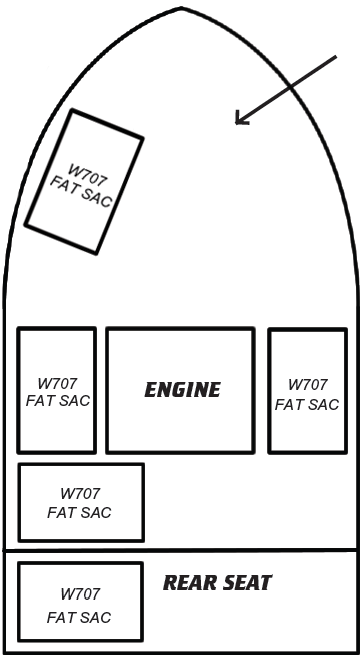
V-Drive
If you have a V-drive boat, the engine is near the rear of the boat. You will want to weigh down the side that you are going to wakesurf on with a greater amount of ballast next to the engine. Then, add a smaller amount of weight directly in front of that, either under the seats or on the seats, still on the side you want to wakesurf on. You want to get a slight lift and always keep the rub rail above the water and experiment from there. See image from Fly High.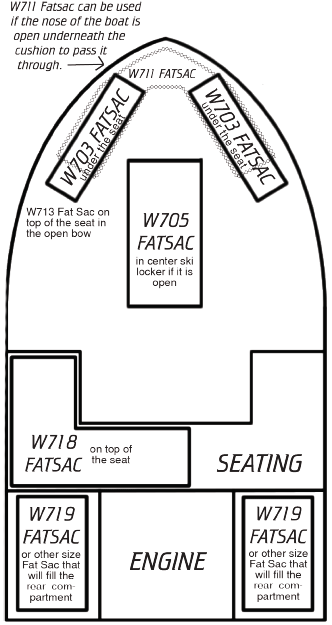
Boards and Ropes
Today’s wakesurf boards span a wide range of riding styles. Almost all major brands that manufacture wakeboards carry a line-up of wakesurf boards too. Finding the right wakesurf board is only the beginning when getting into wakesurfing. Just like any other water sport, there is proper equipment designed specifically for wakesurfing. Check out our guide on choosing the right wakesurf for you: How to Choose a WakesurferWe recommend investing in a great wakesurf rope. Traditional wakeboarding ropes are long and thin. The thicker and shorter design of wakesurf ropes makes maneuvering much easier for the rider. Wakesurf ropes will often have extra knots and grips throughout the rope, allowing the wakesurfer to utilize as much or little of the rope as they want when positioning themselves on the wake. When not used properly, the rope is an added hazard to the safety equation.
Boat Speed for Wakesurfing
Boat speed for wakesurfing will vary with the make and model of boat, and the amount of ballast, but usually good waves form around 10 mph and professional surfers will cap out around 12.5. Skim-style boards perform best at about 1.5 mph slower than surf-style boards. When pulling up a wakesurfer, you should accelerate even slower than when pulling a wakeboarder. You want to start slow and make small incremental increases. Ideally, to start, you want a thigh-high wave with a clean face and no whitewater on the lip.
Wakesurfing Safety
Like all water sports, staying safe is all about the fundamentals. “You need to know your equipment, you need to know the sport, you need to know your crew, and you need to be in a position to command that operation and not jeopardize anyone’s life,” says Todd Gaughan. There’s a lot that can go wrong and you can prepare yourself by knowing the fundamentals. Some states do not require the use of a life vest while wakesurfing or waterskiing, and some don’t even require the use of a mirror or a third person to watch as an observer. So knowing the laws is important, but also thinking above and beyond the law is necessary to keep your friends and family safe. Purchase the necessary safety accessories, like wakeboard vests, a flag, and possibly wakeboard helmets (especially for kids). Go to the Water Sports Industry Association to look up current and historical laws.Learn More With Our Other Wake Guides:
Wakeboard Size Chart & How to Choose
Wakeboard Boots & Bindings - How to Choose
Wakeboard & Binding Compatibility Guide
Wakeboard Tow Speed, Rope Length & Boat Weight
Wakeboard Life Jacket & Vest Size Guide
Wakeboard Ropes & Handles - How to Choose
How to Wakeboard: Beginner Tips & Getting Started
This is evo. We are a ski, snowboard, wake, skate, bike, surf, camp, and clothing online retailer with physical stores in Seattle, Portland, Denver, Salt Lake City, Whistler, and Snoqualmie Pass. Our goal is to provide you with great information to make both your purchase and upkeep easy.
evo also likes to travel to remote places across the globe in search of world-class powder turns, epic waves, or legendary mountain biking locations through evoTrip Adventure Travel Trips. Or, if you prefer to travel on your own, check out our ski & snowboard resort travel guides and mountain bike trail guides.
Still have questions? Please call our customer care team at 1.866.386.1590 during Customer Care Hours. They can help you find the right setup to fit your needs.
